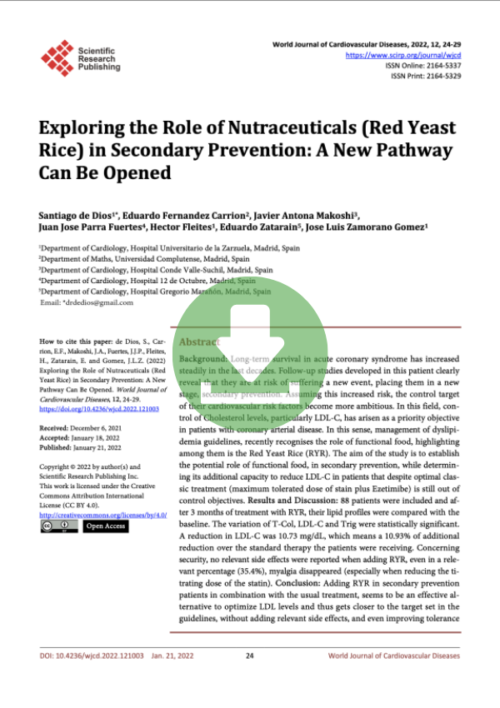An article by Dr. Santiago De Dios (Cardiologist at the Hospital Universitario de La Zarzuela, Madrid) has recently been published in the World Journal of Cardiovascular Diseases. In this prospective observational study (SECLIP), 88 patients have been included who, undergoing 3 months of treatment with Lipok® (red rice yeast, berberine and coenzyme Q10) added to their usual lipid-lowering therapy, have obtained a significant improvement in their levels. of LDL cholesterol, thus achieving the objectives set in its analytical control. During the study, it was also possible to verify better tolerance of standard treatment, identifying more than 30% reduction in myalgia (muscle pain associated with the use of statins) in patients taking Lipok®.
We invite you to learn in depth about the study of Dr. Santiago de Dios, which shows that:
- Adding Lipok® (red yeast rice, berberine and coenzyme Q10) to conventional lipid-lowering therapy is effective in reducing LDL levels (10.93% reduction).
- Adding Lipok® to the usual therapy in dyslipidemia improves tolerance to statins (35.4% reduction).
World Journal of Cardiovascular Diseases, 2022, 12, 24-29
Exploring the role of nutraceuticals (red yeast rice) in secondary prevention: a new path may be opened.
Exploring the Role of Nutraceuticals (Red Yeast Rice) in Secondary Prevention: A New Pathway Can Be Opened.
Santiago de Dios1, Eduardo Fernandez Carrion2, Javier Antona Makoshi3, Juan Jose Parra Fuertes4, Hector Fleites1, Eduardo Zatarain5, Jose Luis Zamorano Gomez1
1Department of Cardiology, Hospital Universitario de la Zarzuela, Madrid, Spain
2Department of Maths, Complutense University, Madrid, Spain
3Department of Cardiology, Hospital Conde Valle-Suchil, Madrid, Spain
4Department of Cardiology, Hospital 12 de Octubre, Madrid, Spain
5Department of Cardiology, Hospital Gregorio Marañón, Madrid, Spain
Abstract:
Background: Long-term survival in acute coronary syndrome has increased steadily in recent decades. The follow-up studies developed in this type of patient reveal that he is clearly at risk of suffering a new event, placing him in a new stage, secondary prevention. Assuming this increased risk, the goal of controlling your cardiovascular risk factors becomes more ambitious. In this field, the control of cholesterol levels, particularly LDL-C, has been raised as a priority objective in patients with coronary artery disease. In this sense, dyslipidemia management guidelines recently recognize the role of functional foods, highlighting Red Yeast Rice (RYR) among them. The objective of the study is to establish the potential role of functional nutrition in secondary prevention and determine its additional capacity to reduce LDL-C in patients who, despite optimal classic treatment (maximum tolerated dose of statins plus Ezetimibe), reach goals that are still out of control. .
Results and discussion: 88 patients were included and after 3 months of treatment with RYR their lipid profile was compared with baseline. The variation of Col-T, LDL-C and Trig was statistically significant. The reduction in LDL-C was 10.73 mg/dL, which means an additional 10.93% reduction over the standard therapy that patients received. Regarding safety, no relevant side effects were reported when adding RYR, even in a relevant percentage (35.4%), myalgias disappeared (especially when reducing the titration dose of the statin).
Conclusion: The addition of RYR in secondary prevention patients in combination with the usual treatment, seems to be an effective alternative to optimize LDL levels and thus approach the objective set in the guides, without adding relevant side effects, and even improving tolerance.
Add Lipok® (Red Rice, Berber and Coenzyme Q10) to conventional hypolipemit therapy is effective in reducing LDL levels (10'93%reduction).
Adding Lipok® to the usual therapy in dyslipremia improves tolerance to statins (35.4%reduction).
Link Clinical Test:
https://www.scirp.org/journal/paperinformation.aspx?paperid=114770
February 26, 2024
—
Ciro Oliva de la Nuez


















